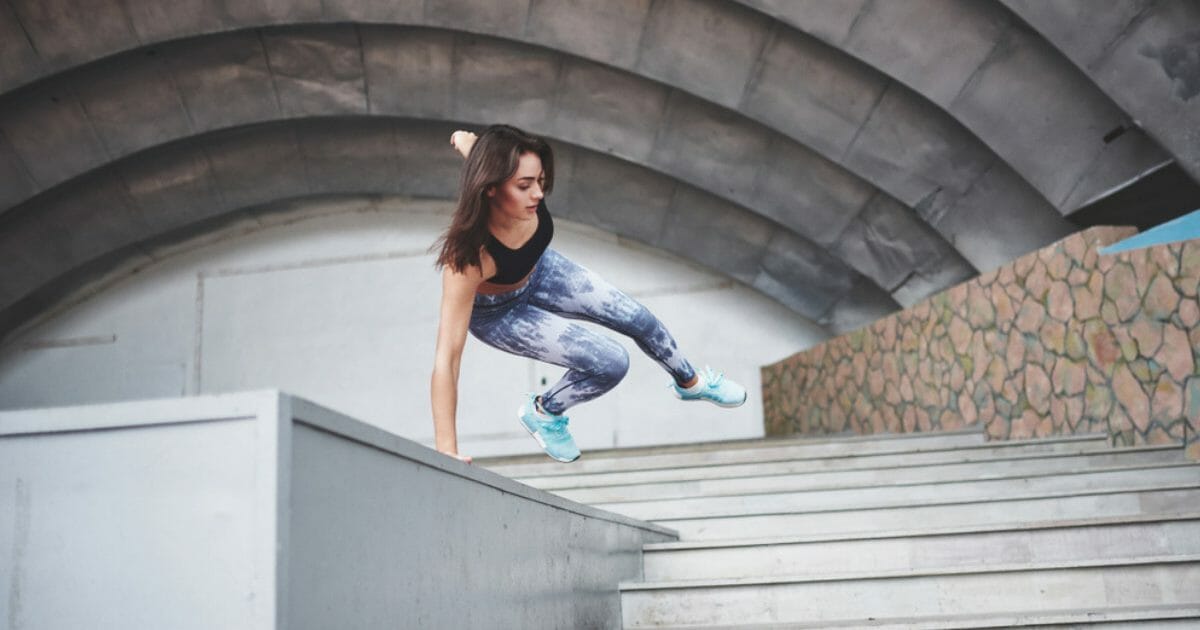General Health
Think Parkour is Just For Men? These 5 Moves Will Change Your Mind
Have you heard of parkour yet? Whether you’ve seen exhilarating clips on YouTube or watched pros go at it in the streets, you might find this energetic discipline quite attractive. So, why don’t you try it for yourself? Contrary to popular belief, this sport is not for the few, but the many. No matter what your skill or fitness level, engaging in this practice could help you to get faster and stronger in no time at all.
When you get a grasp on the sport, you will no longer need to head to the gym to workout – you can do it whenever and wherever you please. Here’s what you need to know.
Page Contents…
- 1 What is Parkour?
- 2 What Are the Benefits of Parkour For Women?
- 3 So, Can Women Do it Too?
- 4 How to Start Parkour Training
- 5 Essential Gear You’ll Need: Parkour Shoes, Pants, and Gloves
- 6 5 Beginner Parkour Moves to Get Started
- 7 4 Safety Tips to Remember When Practicing
- 8 Conclusion
- 9 References
What is Parkour?
Looking for a parkour definition? Also called freerunning, this high-energy sport is the practice of moving quickly and freely through any given terrain. Most often, that terrain will be a city or urban environment. However, it could just as easily be applied to a rural area. The non-competitive activity involves a whole range of motions, including running, jumping, climbing, and quadrupedal movements. As such, it’s a full body workout. The focus is not on competing, but on the art of self-improvement.
Needless to say, parkour involves a range of skills that you will need to develop. You should be agile, at the peak of physical fitness, strong, and have excellent coordination to pull this off. Despite that fact, people of any level can get started. The more you begin to train and work hard at the practice, the further you will get.
History of parkour
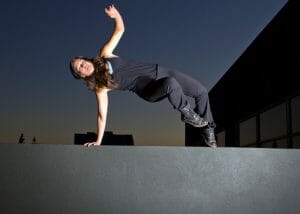
While the sport has risen in popularity in recent years, it actually dates back decades. In the 1980s, a group nine of Frenchmen founded the practice. The original name for the sport was not parkour at all but “Art du Deplacement”.[1] However, some years later in 1998, one of the men, David Belle, renamed the sport “parkour”. The word is a reference to the French term “parcours” which translates directly as “route” or “course.”
Over the years, the sport has become popular with both men and women around the world, but especially here in the US. The energetic practice requires people to vault obstacles, climb walls, and jump onto walls, among other seemingly difficult feats of fitness. For that reason, it could never be said to be a dull or, indeed, boring pastime.
Someone who practices parkour is usually referred to as a traceur. The feminine form of this French word is traceuse.
The difference between parkour and freerunning

So, what’s the difference between parkour and running? Well, nothing, technically. The two terms can be used interchangeably and you shouldn’t worry too much about which you choose to use.
Guillaume Pelletier, a French parkour athlete, invented the word “freerunning” back in 2003.[2] At the time, he was involved in the making a British documentary on the subject of the sport. He chose the term as the best way to convey the essence of the sport to English speakers around the world.
However, since the inception of the word “freerunning”, there has been a slight shift in its meaning. While parkour is about finding the fastest route through an area, freerunners often like to take things to a new level. You may find that they include acrobatic and gymnastic moves in their practice. For instance, it’s more likely that a freerunner would do a flip mid-trial while a parkour athlete would not.
What Are the Benefits of Parkour For Women?
Are you considering giving parkour a whirl? This enticing activity has a wealth of benefits for women. Not only does the sport offer a full-body workout, but it also helps you improve your fitness in a wide range of areas. Before we get started and take a look at how to parkour, let’s have a look at why you might want to try it for yourself. Here’s what you need to know about how this high-speed practice could improve your health and wellness.
Lower risk of cardiovascular problems
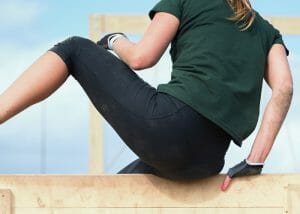
Aerobic exercise is an essential part of parkour training. Participants must run, jump, and generally use a wealth of energy to move around. While this is, no doubt, more challenging than your average aerobics class, we mustn’t ignore the fact that you still get more than a full workout when you take part. This high-intensity activity could have a remarkably beneficial impact on your overall health and, in particular, your heart.
Research from the Universidad de Cádiz found a strong link between moderate and high aerobic exercise and a lower risk of heart attacks.[3] In fact, engaging in an aerobic activity on a regular basis can decrease your chances of suffering from a cardiac arrest by between a massive 58% and 72%. If you’re struggling to find the motivation to attend regular classes, trying something engaging like freerunning could be the answer.
Offers a full-body workout
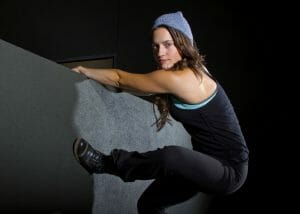
Few sports work the entirety of your body quite as well as parkour or freerunning. From using your core strength to lift yourself over obstacles to raising your heart-rate by sprinting, this practice requires you to push your body to its absolute limits. The benefits of taking up a sport like this one are almost endless when it comes to your fitness.
And that’s not a bad thing. Training in these intense conditions means that you work all areas of your body. The sport combines strength training, aerobics, and, in some cases, even gymnastics. What’s more, the sheer diversity of the practice is perhaps what makes it so much fun when you first start out. Unlike other sports, it gives you the chance to experiment with a wide range of practices and improve your fitness as you move.
Helps lift your mood

Feeling a little down in the dumps? We all have days when our emotions are low and we don’t quite feel ourselves. When you’re feeling a bit blue, one of the most effective solutions is to work out and engage in some form of activity. As we have already covered, parkour combines a selection of sports and practices to create one original activity.
Research suggests that taking part in acute (i.e. extreme or serious) aerobic exercise could help individuals regulate their moods and literally feel happier.[4] If you have trouble managing your emotions, like so many of us do, using exercise as a way to solve this problem is a healthy way to cope. Parkour is one of the more extreme forms of cardio or aerobic workouts in which you can engage, making it the ideal way to go.
Could help to relieve insomnia

Insomnia isn’t merely about failing to fall to sleep. In the US, between 30% and 35% of us suffer from mild bouts of insomnia. Plus, a further 10% of people in the country have to battle what’s known as “chronic insomnia disorder”.[5] The symptoms of these conditions include fatigue, a lack of focus, poor memory, erratic moods, and low motivation.
The condition is more prevalent among women than it is men.[6] To make matters worse, this particular condition increases in likelihood as we age. It’s crucial that we each do all we can to avoid the problem in any way possible. Should you be struggling with this particular condition, finding a way to manage it will be your top priority.
Research from Northwestern University linked regular aerobic exercise with a higher quality of overall sleep at night.[7] The participants who took part in the study all suffered from self-reported insomnia. They were split into two groups, one of which took regular exercise, while the others did not. Both groups received information about improving their sleep and changing their habits.
The results indicated that engaging in a form of exercise in the day could seriously improve how much sleep (and the quality of sleep!) you get at night. Those in the active group had a higher level of improvement when it came to their sleep and rest patterns. As though that weren’t enough, they also reported fewer depressive feelings and more vitality.
So, Can Women Do it Too?
“Can women practice parkour?” is one of the questions that comes up all too often when we talk about parkour. Perhaps this is because it tends to be a male-dominated sport, so some women may wonder whether they would be able to do the moves, let alone fit in with the community. Some may even wonder if it’s safe for women to do.
The short answer to all of these questions is, yes – of course!
Much like CrossFit and other extreme sports, there’s simply no reason that this particular practice should not be accessible or safe for women to practice. In fact, there are many professional female parkour trainers out there, who are leaders within the field.[8] The parkour community is known for embracing anyone who expresses interest in joining, so don’t fear approaching a group near you!
The popularity of parkour among women is certainly growing lately too. For example, in Egypt, there’s been a recent surge in the number of female parkour athletes, according to a report by Reuters.[9] This trend highlights that it is indeed a practice that both men and women alike can learn. Of course, whenever you’re training, it’s important that you work to a level that matches your skill and current fitness as well.
What’s more, many women have taken their parkour training to an entirely new level of late. The World Freerunning and Parkour Federation list number of female athletes who have made a name for themselves in the field. Notable women in the sport include Krisnara Almeida from Brazil and Beth Holland from the UK.
How to Start Parkour Training
Now that you’re clear on the parkour meaning, it’s time to take a look at how you can get started. It’s worth understanding that there are some strikingly simple moves that you can try for yourself at home. However, if you’re truly serious about becoming an athlete, you will need some expert advice and support along the way. Luckily, thanks to the growing popularity of this sport, you should have no problem finding somewhere to train.
Parkour classes and training
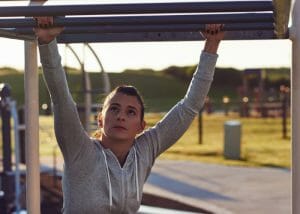
Parkour doesn’t just happen on the street. You can find parkour classes just about anywhere in the country. When searching for a parkour training session, make sure that you’re clear about what you want. You should look for a session that is specifically for beginners, rather than one at a higher level. This type of discipline can be extremely difficult and if you go in at a level that’s too high, you could run the risk of injury.
So, what should you expect from your first set of parkour classes? Sadly, you’re unlikely to be climbing massive walls in your first training session. The beginners’ exercises are ones that you will most likely be somewhat familiar with. As the aim of the game is to build your core strength, you will likely find yourself doing sets of sit-ups, push-ups, squats, and pull-ups when you first get started. Don’t worry – this won’t last forever.
After a matter of weeks, when your strength has improved, it will be time to move onto some more exciting parkour moves. Since jumping is such a fundamental part of your parkour training, it’s probable that this will be the next thing on which you focus.
You will learn skills such as precision jumping, vaulting, and, of course, how to land safely. The point here is not to rush the process; it takes some longer than others. Instead, focus on being concise in your movements and getting each one right. Of course, as you train more and more, you will be able to unlock new skills and try new moves.
How to find the right parkour gym for you

When you’re looking for classes, using the search term “parkour gyms near me” is a good place to start. However, you may also want to look on the official American Parkour website.[10] The academy runs a variety of parkour classes for all skill levels in Washington DC. Aside from that, you can attend summer camps and programs throughout the year.
If you don’t live in the Washington area, there’s no need to fret. You should have no issue finding parkour classes nearby. When checking out sessions, you should ask one simple question: Is this instructor American Parkour (APK) certified? Trainers with this particular certification should have all the skills that you need to progress quickly and easily through the program. While there may be good trainers without this qualification, it’s worth looking for an athlete in which you can have the utmost confidence.
Essential Gear You’ll Need: Parkour Shoes, Pants, and Gloves
As with most extreme sports, you will need to make sure that you have the right type of gear before you get started. Choosing both clothing and protective items that are fit for purpose will go some way to making sure that you’re safe and secure when engaging in parkour training. If you need a little help along the way, we completely have you covered. Here’s a quick rundown of the types of parkour gear in which you should invest.
Parkour Shoes

Image credit: Nike
Perhaps one of the most important pieces of parkour gear you will need is a sturdy pair of shoes. Major female parkour shoe brands include Nike and Rochester Parkour. When looking for the best parkour shoes, there are a few things that you absolutely have to keep in mind. Each pair of parkour shoes should have:
- Cushioning/padding – Opting for a pair that gives you extra comfort through padding in the sole is the smartest way to go. Often enough, when you’re training, you will find that you have to jump and land quickly. This extra level of protection will make you feel super comfortable.
- Lightweight – When you’re running and jumping around, the last thing you want is anything that’s about to slow you down. With that in mind, you should opt for a lighter pair of shoes. Pick some that have a thin, canvas material. You can also check the weight in the product description to make sure that the shoes aren’t too heavy.
- Flexible with high arches – When it comes to flexibility, one of the major things that you need to look for is high arches. There should be a defined arch in the middle of the shoes. Make sure that the arch is as flexible as possible. You can move them yourself to see how much they will bend.
- Compound soles – The best parkour shoes tend to have a high level of grip. Before you buy a pair, take a look at the bottom of them. You want a pair of shoes that have hard compound soles, i.e. ones that are made out of durable, hard-wearing material. These will help you to stay on track.
Parkour Pants

Image credit: Tempest Freerunning
When it comes to choosing parkour pants, it’s essential that you pick a pair that doesn’t restrict your movement in any way at all. This sport will see you running, jumping, and quite possibly contorting yourself into some rather odd positions. With that in mind, you need to ensure that the parkour gear you get is suitable for the activity.
You can get specifically tailored parkour pants in stores these days. If you’re willing to invest in a quality pair of pants, choosing one of the high-end brands is certainly the way to go. There are still more options for men than women at the moment, but many designs are rather unisex. Some of the most popular brands include Farang Clothing and The Motus Projects. Take the time to check out what each has to offer before choosing a pair of parkour pants that suit you.
Parkour Gloves
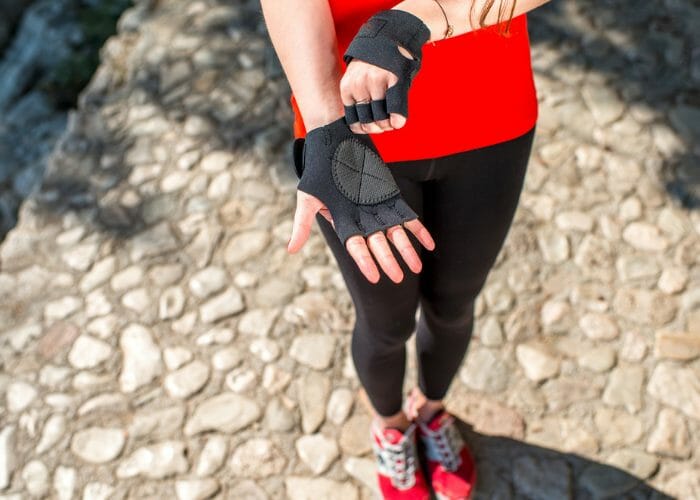
First starting out in parkour? One of the most essential pieces of gear you should get is a pair of gloves. You will use your hands during freerunning and parkour much more frequently than you would in other types of training. That’s why you should make sure that you protect your hands and do all that you can to prevent any injuries. Top glove brands include Harbinger Fitness and Seibertron Outdoor. Here are a couple of the key features you need to look for in parkour gloves:
- Fingerless – Flexibility is key when it comes to your parkour gloves! Fingerless ones tend to work best, allowing for more movement than full gloves. Look for a pair of gloves that offers a little support around the base of each finger but does not have the full material in that area.
- Strong and hard-wearing – You need a pair that is made from hard-wearing material and gives you a high level of protection. Look for a reinforced material with an inner and outer layer. Some parkour gloves actually have plastic or netted paneling on them, which give you more grip than you would otherwise have. The stronger they are, the better!
Protective Gear
Finally, let’s take a quick moment to talk about protective parkour gear. It just so happens to be a rather controversial topic among freerunning and parkour athletes. Wearing too much protective gear can hinder your movement and, essentially, slow you down. Don’t make that mistake. However, when you’re new to the practice, you may feel more comfortable with some level of protection. You can wear knee and elbow protectors and similar protective gear, but it’s not recommended in the long-run.
5 Beginner Parkour Moves to Get Started
Ready to give parkour a shot? While you’re unlikely to be scaling buildings from the offset, there are some beginner parkour moves you can try right away. These next activities don’t take an uber high skill level but will help you to work on your strength, flexibility, and agility. Heading to your local parkour gym is the best place to start as they will have all the gear and equipment, not to mention advice, that you could ever need. Here are five moves.
1. High Jump
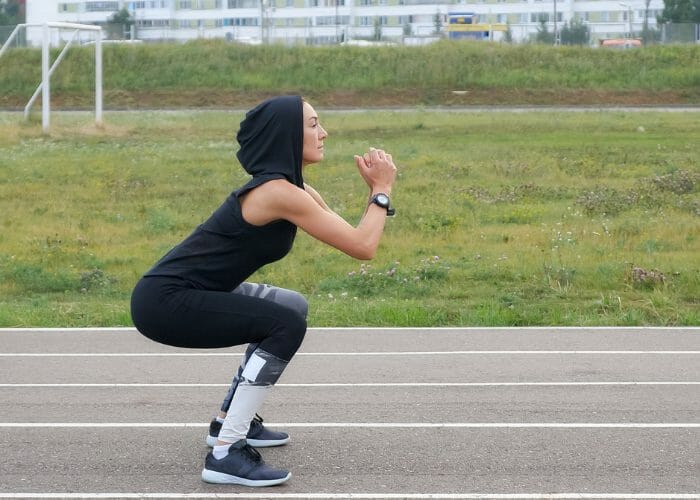
The high jump is just what the name describes – a jump in which you leap as high off the ground as you can manage. When you start properly parkour training, you will need to jump directly over various objects, walls, and obstacles. Height is crucial. One of the ways in which you can practice is by learning to high jump.
- Targeted muscles: Quads and core
- Repetitions: 20 per set
- Time: 5 minutes
How to do it
You can do this is your gym or at home. Start with your legs apart and your knees slightly bent. Crouch down and in one swift movement jump upward. Try to gain as much height as you can. Repeat this action 20 times in sequence. The more you practice, the higher you should be able to go. Keep at it! You should try to engage in this particular parkour activity every day for the best results.
Pro Tip: Learning the high jump has a very distinct purpose. When you’ve managed to gain enough height, you can add to this move. As you’re going to be using this skill to jump over obstacles, you need the ability to propel yourself forward at the same time. This next part of the move will take some practice to get right.
When you’re in mid-air, shift your body as far forward as you can manage. You can use your arms to gain movement by shifting them swiftly backward as you jump. Try measuring how far you move each time and attempting to beat your record.
2. Swinging Through
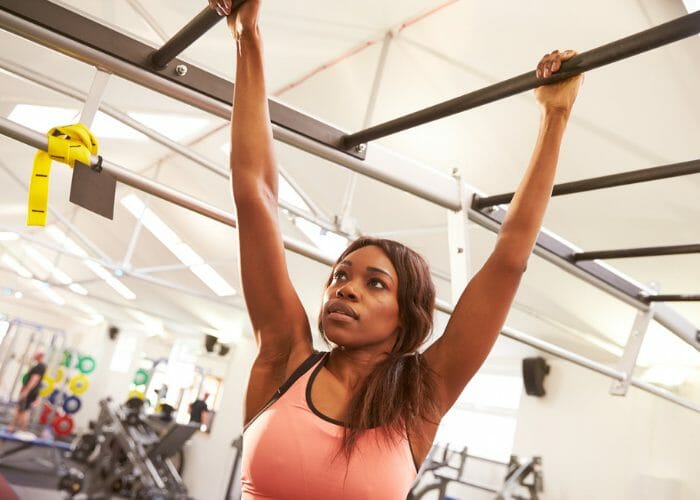
You will need professional equipment in order to execute this move so it’s best to hit up a parkour gym and get practicing. Swinging Through is a method of traveling, which is often used as part of the main type of parkour training. Much like you played on the monkey bars when you were a child, the move requires you to swing from bar to bar.
- Targeted muscles: Biceps, triceps, and core
- Repetitions: 10 bars per set
- Time: 2 minutes
How to do it
You will need to use the parkour bars in your gym for this particular exercise. Begin by taking a run up to the bars to give you some speed. When you reach them, jump as high as you can and grab hold of the first bar with both hands. Swing backward and use that motion to propel yourself forward with as much force as possible.
Next, grab the following bar with one arm and swing your entire body forward. Continue in this motion for around 10 or more bars. Of course, you should listen to the advice of your parkour trainer when you’re completing this move. As you practice, you should gain upper body and core strength, both of which will boost your fitness.
Pro Tip: When you first get started with this parkour move, you may find that it’s helpful to keep one hand on the bar as you swing to the next. However, as you progress, you should find that you can kick things up a gear. Leaping from bar to bar (by letting go of each bar) is a skill in itself. Of course, you will need an expert to advise you along the way.
3. Tic Tac
The art of parkour is all about using the urban environment to inform your practice. Of course, one of the things that you will use time and time again is the humble brick wall. Before you start scaling these things and using them in some extreme parkour training, this is a simple move that you can learn for yourself.
- Targeted muscles: Quads and core
- Repetitions: 10 per set
- Time: 2 minutes
How to do it
First of all, you will need a wall on which to practice. Your local parkour gym will have a safe wall that you can use. The first step is to run toward the wall at a diagonal angle. Note: You don’t want to run directly toward the wall or you could cause yourself an injury.
When you reach the wall, leap up with one foot and push the other foot toward the wall. Use it as a springboard to push yourself off and leap at a 90-degree angle away from the wall. You should use as much force as possible.
Pro Tip: While you will need speed to pull off this particular parkour move, you should make sure that precision comes first. Should you put your foot in the wrong position, you will find that you end up hurting your ankle. Take the time to ensure that you get the move right, rather than trying to rush through it.
4. Safety Land/Parkour Roll
As we’ve already discussed, one of the core practices when it comes to parkour is jumping. Before you go hopping around, though, you need to make sure that you know how to land correctly. The last thing you want is to hurt yourself when you first take off.
- Targeted muscles: Quads and core
- Repetitions: 10 per set
- Time: 3 minutes
How to do it
Before you attempt this move, you need to make sure that you have a soft gymnastics mat. You can start out by doing any possible jump you feel like. As the name suggests, it’s the landing that’s important here. As you come down into landing position, you should bend your knees and crouch down low. Roll over your shoulder and leap to stand again.
The entire move should be one fluid motion. If you’ve ever done a forward roll, you will find that the skill will come into handy now. Of course, if you’re completely new to this type of movement, you should practice it as often as possible. The more you try to get it right, the better you will find the landing process. Give it a go!
Pro Tip: Learning landing for yourself? Don’t make the mistake of trying to do this move alone. Having an instructor with you will mean that you get the process right. You should also ensure that you don’t put your weight on your upper body as you roll over. Doing so would put you at risk of an injury. Always put your personal safety first at all times.
5. Stride
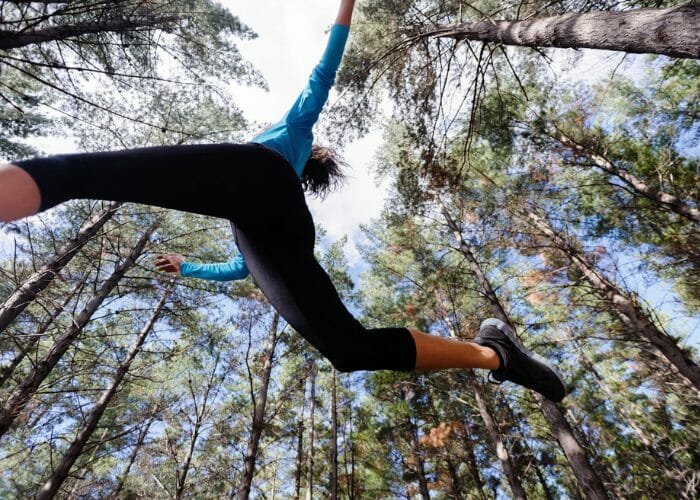
Moving quickly through any environment will take you a series of strides. With that in mind, mastering this basic parkour move is a sure-fire way to improve your skill set. There are two ways in which you can practice this move – either on the floor or across a series of small objects or boxes.
- Targeted muscles: Quads and core
- Repetitions: 20 per set
- Time: 4 minutes
How to do it
For the basic move, you will need to complete a series of precision leaps. Start at one end of a track, and leap with one leg forward. As you land, you should push the other leg forward and leap onto that foot instead. The complete move will look like a gliding or running motion. Again, while you need to gain speed during this move, you should mainly focus on getting your footing correct and landing safely. Try a sequence of 20 strides.
Pro Tip: When you’ve mastered this move on the ground, it’s time to take it to the next level – literally. Place a series of short boxes (plyometric boxes will work well!) next to one another in a linear structure. Now, it’s time to put your skills to the test. Start by standing on one of the boxes and using the striding motion to move from box to box. Take care not to fall!
4 Safety Tips to Remember When Practicing
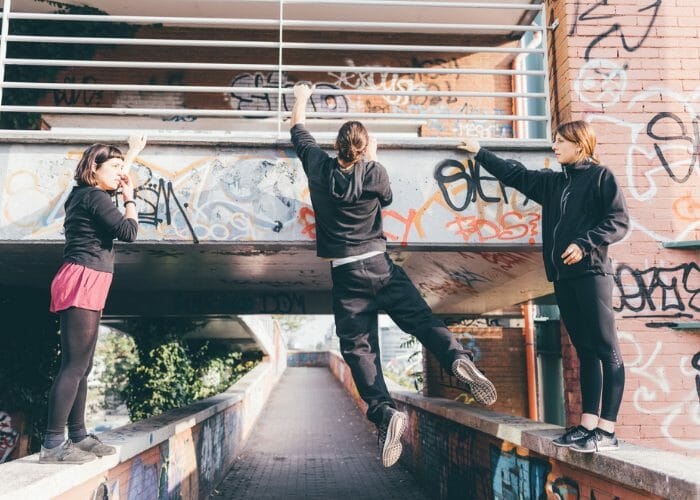
Your safety should always be your top priority. For that reason, it’s worth keeping a few small golden rules in mind when you begin to train. As with all extreme forms of exercise, you will find that your risk level soars when you give this a go. Of course, you need to make sure that you work with an instructor and expert at all times. Plus, there are some extra safety measures you can take too. Here are four things of which you should be conscious at all times.
- Don’t try parkour at home!
While there are some moves you can do at home, such as simple squats, sit-ups, and push-ups, most standard parkour moves need special knowledge and equipment. With that in mind, it’s worth finding a parkour gym as soon as you’d like to begin training. That way, you can tap into the expertise of the trainer to help you along the way. - Progress slowly and steadily
Make no mistake, learning the practice of parkour will take you quite some time. You will by no means be a professional athlete overnight. And nor should you expect to be. Take things slowly and progress at your own level. Listen to your body. If you feel that you’re pushing yourself too hard at any point, stop and take things more slowly. - Always stretch before you begin
You should never underestimate the power of stretching. You need to limber your muscles well enough before you undergo any extreme form of physical exercise. There are different types of stretching you can engage in, each of which will help you prepare for your activity. Get into the habit of stretching before you start out with any given routine. - Fuel your body with nutritious food
When you’re taking part in any form of intense exercise, you burn a whole load of energy. Of course, you need to give your body the fuel it requires to move. Eating a balanced diet is the baseline rule here. You may also want to supplement this with some protein bars and balls. That way, you can ensure that you never run low on energy!

Conclusion
What are you waiting for? Now that you know all there is to know about parkour, you can go ahead and get started. This highly diverse sport allows you to use a range of skills and abilities. Adding it to your training routine is sure to increase your fitness while also allowing you to develop your agility and more. Find a parkour gym near you today and embark on an entirely new journey into health and wellness.

